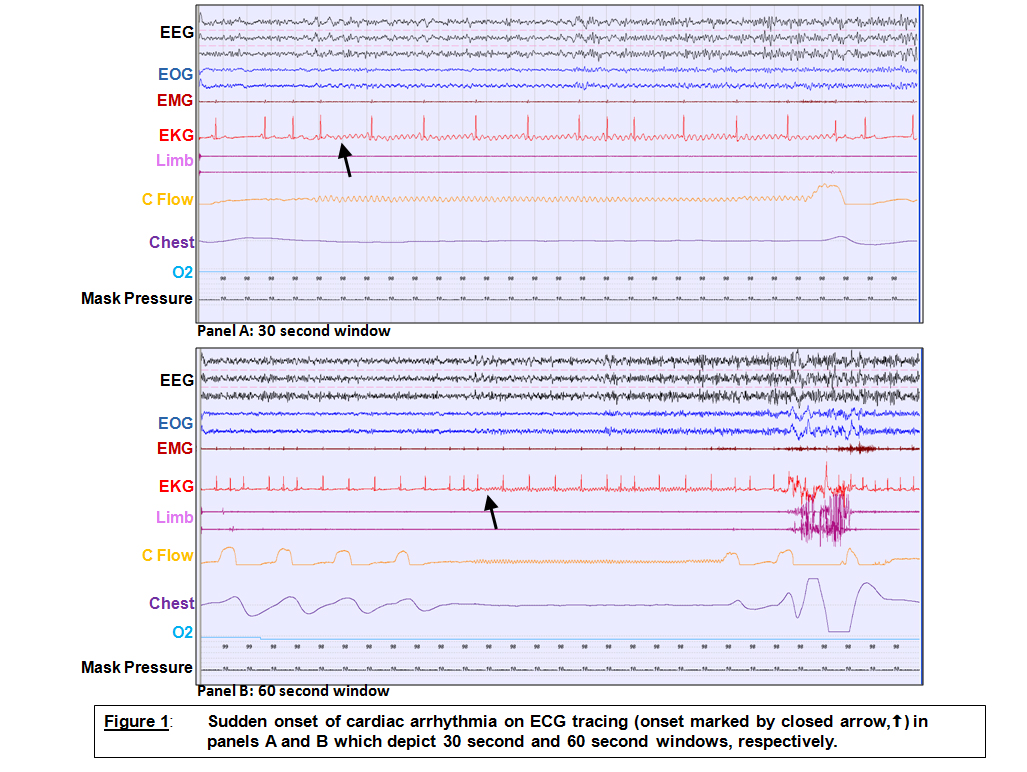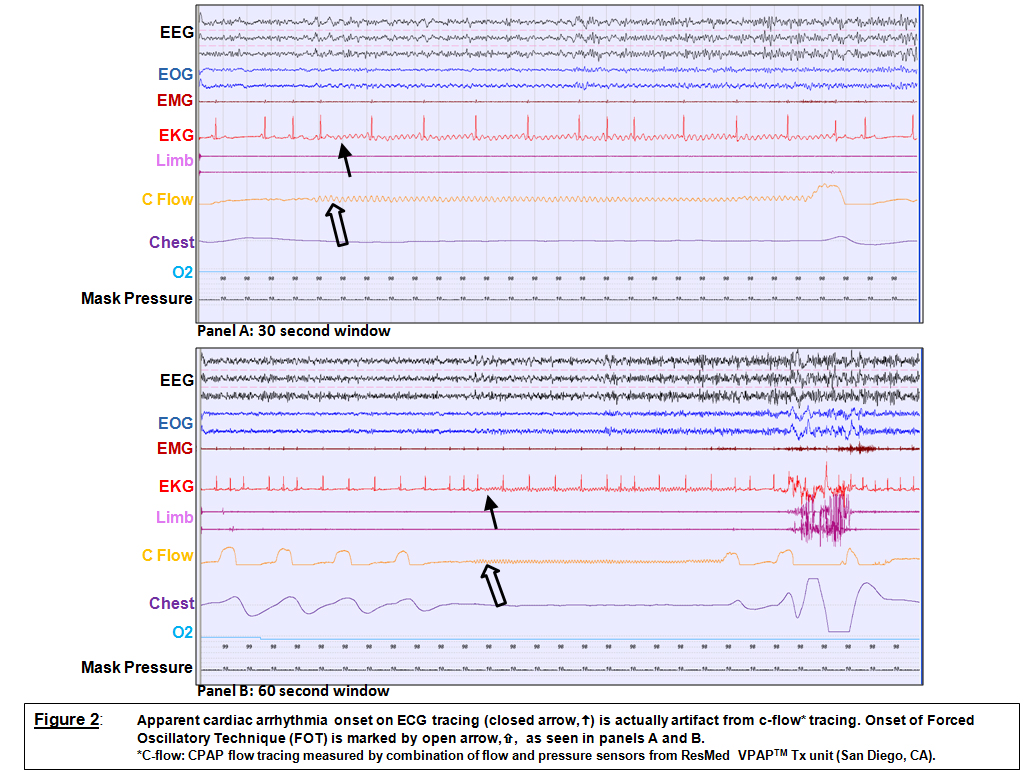Contributed by Amit V Patel, Arthur J Spielman, Matthew R Ebben, Ana C Krieger, Weill Cornell Center for Sleep Medicine, Weill Cornell Medical College, New York, NY
A 61 year old man underwent split-night polysomnography due to complaints of loud snoring and sleep- related apneas as noticed by his wife. Severe obstructive sleep apnea (OSA) was noted during the initial 77 minute diagnostic portion of the study (AHI 73 / hr) and a CPAP level of 10cm H20 was found to treat effectively the patient’s obstructive events during the therapeutic portion. However, frequent central apneas appeared and the patient was switched to an adaptive servo-ventilation (ASV) unit. On initiation of ASV, during two central apnea episodes (post arousal in nature), the sudden onset of an ECG abnormality was noted (figure 1) as demarcated by the arrows in panels A and B which depict a 30 second and 60 second window, respectively, of one such instance. The ECG abnormality dissipated upon the patient’s resumption of breathing in both instances.
What finding is most consistent with the observed ECG abnormality?:
- Seizure-related artifact
- Apnea induced atrial flutter
- Positive Airway Pressure(PAP) device related artifact
- Apnea-induced atrial fibrillation
- Cardiogenic oscillations on airflow signal
Answer:
3. Positive Airway Pressure(PAP) device related artifact
Discussion:
After careful review of all channels at the time of the potential “arrhythmia” resembling atrial flutter, the pattern on the ECG tracing (Figure 2, closed arrow) was noted to be identical to the sinusoidal oscillatory pattern noted on the PAP flow (c-flow) channel (Figure 2, open arrow). The oscillation in the c-flow channel is due to the forced oscillation technique (FOT) which is a low amplitude, high frequency oscillation of pressure used by a variety of PAP devices to aid in differentiating between central and obstructive apneas.1,2 It is also utilized in the clinical setting for the investigation of respiratory mechanics.3 In the specific device used during this case, the FOT algorithm consisted of a 1 cm H20 pulse of pressure delivered at a frequency of 4Hz by the machine upon sensing an apnea and ceases upon sensing resumption of respiration.2 The frequency of oscillation of the patterns in question noted on both c-flow and ECG channels is consistent with this device’s FOT feature (low amplitude oscillation at frequency of 4 Hz), as is the fact that the oscillations ceased once respiration started. Though this pattern was noted throughout the night during other apneic episodes on the c-flow channel with this particular device, we conjecture that the similar artifact observed on the ECG tracing was only noted in these two instances due to the specific body and arm position of the patient which was identical at those times. More specifically, the patient was in the supine position with his right arm extended above and touching his head during the times of the specific ECG artifact. This finding does not represent a cardiac arrhythmia, seizure related artifact or cardiogenic oscillation on airflow signal4 as the ECG artifact is clearly generated by the c-flow channel.
This case underlines the importance of searching for artifactual causes of any abnormal findings on overnight polysomnography. Artifacts on ECG tracings are a common occurrence during sleep testing with the patterns mimicked by certain artifacts being more alarming than others, therefore careful evaluation of ECG abnormalities is advised.
References:
- Armitstead JP, Wimms AJ, Bateman PE, Benjafield AV, Richards GN. Study of a novel device for the treatment of obstructive sleep apnea. Am J Respir Crit Care Med 2010;181:A556
- Armitstead JP, Richards GN, Wimms A, Benjafield AV. Central sleep apnea detection and the enhanced autoset algorithm. Applied Research and ResMed Science Center Publication. Sydney, Austrlia; 2010
- Oostveen E, MacLeod D, Lorino H, Farre R, Hantos Z, Desager K, Marchal F. The forced oscillation technique in clinical practice: methodology, recommendations and future developments. Eur Respir J 2003; 22: 1026-1041
- Ayappa I, Normal RG, Rapoport DM. Cardiogenic oscillations on the airflow signal during continuous positive airway pressure as a marker of central apnea. CHEST 1999; 116:660-666





